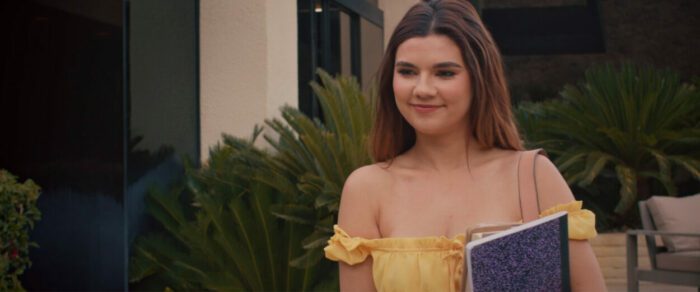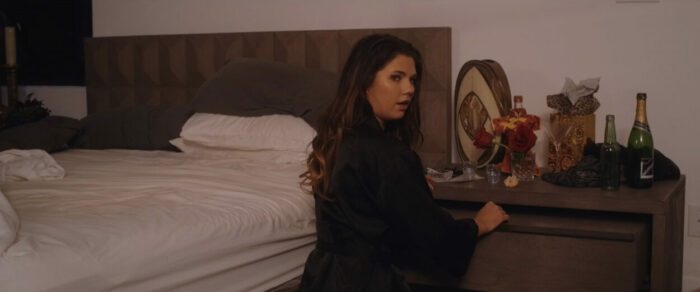There are a myriad of different ways to talk about Girls on Film (2023). Coming from director, writer, producer, actor, editor, and co-cinematographer Robin Bain, it’s clear that it came from a very deep desire to tell a particular type of queer story.

Starting with Jenna “Rain” Thayer (Dare Taylor), Girls on Film follows a young sex worker as she navigates life with her new unstable roommate Blake (Willow Grey). As things progress, the focus shifts, putting Jenna in the backseat while Blake takes the spotlight, showing why she acts in the ways that she does.
There are more than enough angles to take with Bain’s film, but starting with sex work seems to be the obvious choice. Girls on Film tries very hard to give an accurate depiction of sex work in a society that seems more aware of it than ever. While this is certainly admirable, it’s almost impossible to ignore the reality that the film’s depiction feels like an outsider looking in. Girls on Film is no stranger to voyeurism, but its depictions of this kind of labor feel tired, even including scenes of full-service sex work for an online creator.
There are so many interesting stories to tell with characters who are modern-day sex workers, which makes every mention of those stories stand out. Bain makes a distinct point to show Jenna facing housing and financial insecurities, blatant wage theft, and a lack of legal protections, all very real issues. While the inclusion of these elements is fantastic, there’s not enough for the story to go places with these concepts.
Jenna’s fear of sharing her real name is something so real and palpable, and yet the reasons she cites feel banal. In speaking with online sex workers, it becomes clear that many use an alternative name for their safety, while Jenna seems to only cite her own shame. To Bain’s credit, other films would hesitate to involve themselves with the relationship with one’s own persona.

There’s a fear in so many films to show actual queer romance, let alone scenes of actual intimacy. Be this as it may, Bain doesn’t shy away from showing what she needs to tell this story. The film constantly blurs the line between itself and the content being filmed within it. Voyeuristic displays become as much a part of the film’s narrative as the script itself. It may be off-putting to some, but displays of real life in film often are.
Perhaps unintentionally, the dialogue and its delivery verge on that which one could find in pornography. Given the film’s subject matter, this feels oddly appropriate, with the lines of who Jenna and Blake are off-camera blurring with their online personas. In any other film, this would be received poorly, but here it feels so intentional and thematically appropriate that it’s difficult to pretend otherwise.
Blake, as the film gradually reveals, has more than her fair share of issues. With a history of addiction and a clear on-screen depiction of mental health issues, she constantly takes the story in new directions. Her struggles with addiction are shown constantly, in a way that is perhaps a little tactless but does send a very clear message.
The film’s understanding of the cycles gone through by those with addiction is on clear display, with the cinematography focusing on substances more and more as Blake seems to spiral out of control. Focus is always placed on what characters desire in a scene, building more connections to the film’s subject matter. No matter the scene, the camera is showing some kind of want, some kind of goal. Even in simple shot and reverse shot it’s afraid to linger, instead seeking out a reaction as each revelation is shared.

With costume design seemingly plucked straight out of an actual content creator’s wardrobe, credited to Rebecca X, there’s a strict reality in these characters. All of the outfits feel lived in, real in a way that so many films of a similar budget struggle to find. Every article is instantly recognizable as being Jenna and Blake’s distinct tastes and color palettes. Credit where credit is due, every single character in this film has their own style of clothing that’s unique to them.
Girls on Film tries to do a lot in its roughly 90-minute runtime, and for every plot thread that it seems to lose grasp of, a more provocative one appears in its place. For every part of the film that feels limited by its scope, there are two more that show a well-defined style and skillset. The characters themselves are so non-static that it feels difficult to place them as firmly being in any true arc, something not entirely unrealistic.
While Robin Bain may not be an expert in the fields she presents on screen, she does so with honesty, seeming to come from a place of empathy. So many other directors would struggle to work with, let alone on, this script. Bain, though perhaps slightly overextended, manages to keep a clear focus on the film’s characters in a way that keeps Girls on Film in a viewer’s mind long after the credits roll.




